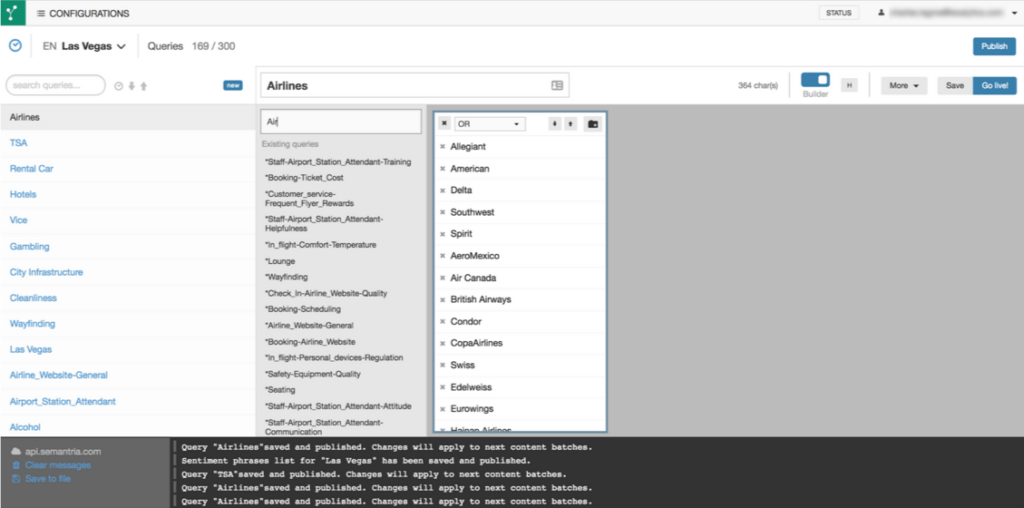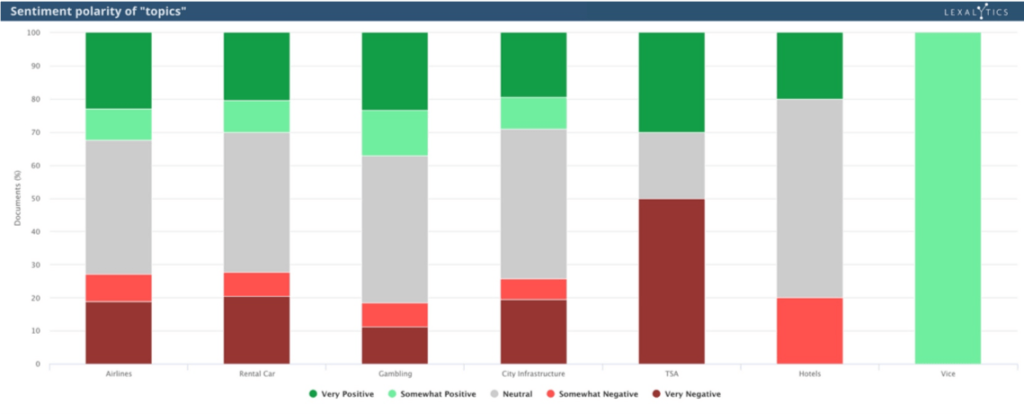Airport Series: McCarran and Las Vegas
When an airport company reviews social data they need to be able to find the signal in the noise. Airports and the cities they serve are often confusingly interchanged on social media. In this article, we use filters and a custom configuration to see exactly what people are saying about McCarran International Airport.
Pop-quiz: what do you think of when you imagine Las Vegas?
Prostitution, gambling, hotels, and recreational marijuana might come to mind. But rather than fighting these associations, Las Vegas’ McCarran International Airport embraces them.
For example, the airport has “pot amnesty boxes”, where people can dump their legally-purchased weed in the event they’re traveling to a state or country with stricter regulations. And they’ve installed slot machines in the terminal, so travelers can get a jump on their gambling.
Or, as one Facebook reviewer put it, “try for one last hurrah.”

A city and its airport
However, this inextricable link between a city and its airport can pose a problem for a business analyst. For example, we recently sourced thousands of reviews from Las Vegas McCarran International Airport’s Facebook page. While analyzing this data set we discovered an interesting phenomenon: reviews on their Facebook page frequently criticized not just McCarran International, but also the city of Las Vegas itself.
Of course, listening to natural language reviews of Las Vegas is interesting. But it’s not useful for a business analyst tasked with understanding how customers experience the airport.
Finding the signal in the noise
To cut through the noise, we configured an analysis to extract what’s being said about McCarran International Airport based on reviews that mention both McCarran and Las Vegas.
To do this, we used Lexalytics’, an pearl-plaza.rupany, web-based dashboard, Semantria Storage & Visualization (SSV). SSV allows any business person to create configurations and run an analysis, even if they have no previous experience with data analytics.

To start, we used the SSV configuration builder. We can easily train the analysis to recognize sentiment in the text data set pertaining to other brands, such as the airlines flying into the airport, or even the city of Las Vegas itself.

First, let’s take a moment to appreciate how the sentiment surrounding “vice” is only positive. In Las Vegas, it seems, vice is virtue!
Now, let’s pull this apart. In this data set, many customers complain about construction on the highway and roads leading to the airport. If our hypothetical business analyst working at the airport doesn’t configure their analysis properly, complaints about this roadwork may impact the sentiment score for McCarran. This will skew the results of the analysis, as civic works, like road construction, are outside the purview of the airport.
However, accounting for this can be tricky. Take this Facebook comment from March 2017, in which a customer complains about road construction:
“Our experience with the airport was overall great no problems at all I just don’t understand why car rentals can’t cooperate and have transportation inside the fence. Then there’s traffic congestion and detours everywhere. A 5 minute trip takes 15-20”
A properly-configured data analytics tool can split this review into its components.
For example, our own Semantria will sort this comment as positive for the airport, while identifying the other entities involved. In this case, “Overall great” adds +0.2 to McCarran’s sentiment score, while “car rentals” and “city infrastructure” get dinged -0.16 and -0.19 respectively.
Working with airport partners
Within any given airport, customers are exposed to numerous third-party vendors and agents. By tuning our analysis, we can focus on conversations about airlines, rental car agencies, and the TSA — all of which are operated by authorities independent from the airport.
Ultimately, these insights will help airport stakeholders share valuable intel with the brands that act as airport ambassadors every day. Furthermore, an analysis like this allows the airport to drill down into relevant conversations where they might affect change.
McCarran customer insights
Overall, analyzing Facebook reviews of McCarran International Airport shows us a mixed bag of opinions. There are some complaints about the cost of food and beverages (although we could say that high prices are inevitable, as the airport shares the retail concession with their restaurant partners, driving prices upward).
A whopping 48% of baggage handling reviews are negative, citing lost, damaged, or delayed luggage. If baggage isn’t delayed, the customers are. Many comments focus on out-of-service doors, people movers, and more.
Says one commenter on Facebook:
“Looked great with the Welcome to Vegas signs BUT couldn’t get to baggage collection as the doors were broken, no airline or airport staff or signage to say how to take a different route. You guys may know it, but visitors don’t!”
Speaking of signage, wayfinding is a consistent problem. As we’ve learned in the past, wayfinding is crucial to the success of an airport.
There are places where McCarran outshines the rest. In 2005, the airport became one of the first to provide complimentary Wifi. Thanks to an emphasis on network friendly infrastructure and regular uptime airline passengers are able to enjoy complimentary unlimited connection even while their on the tarmac. Stuck on a grounded flight? Now you may connect to an LAS branded wifi hotspot and while away the delay. This brand experience goes a long way in promoting customer retention. The emphasis on wifi as a customer experience touchpoint is something an airport company can suss out using text analytics. And, as we’ve pointed out with other examples, this intel can then be baked into the very fabric of the facility.
This fact is reinforced by Samuel G. Ingalls, assistant director of aviation, information systems at LAS, “By the time we started construction on our new Terminal 3, which opened in June 2012, we had a pretty good idea about where to place the Wi-Fi antennas for maximum effectiveness.” The work on expanding network connection onto the tarmac was put to a test in 2015 when 170,000 tech oriented conference attendees descended on Las Vegas. Mr. Ingalls and his team might’ve used text analytics to mine feedback about the experience of these power users, identifying any problem areas. “I saw many people around the airport with at least three devices.” reported Ingalls. “And we didn’t get any negative feedback from these attendees, who used the Wi-Fi system both inside and outside the terminal. I considered that a very positive sign.”
What should McCarran do with these insights?
McCarran might use this social data to design a 2019 budget aimed at solving problems real customers encounter every day. Natural language data is the single best resource for businesses to make profitable decisions. Now, with tools like Semantria Storage & Visualization, all stakeholders in a business may leverage this resource, even if they have no data analytics experience.

